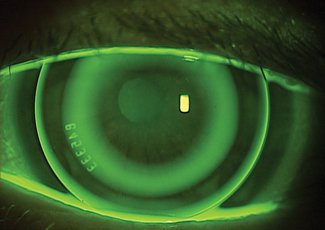 |
| Though ortho-K lenses currently don't take up much of the contact lens market, the number of ODs who fit these lenses is expected to grow significantly in coming years. Photo: Robert Ensley, OD, and Heidi Miller, OD |
Growing uptake of myopia management efforts is putting wind in the sails of the orthokeratology specialty. Recently, researchers distributed a nationwide survey to eyecare providers who manage ortho-K patients to determine the state of the ortho-K market for contact lens wearers. They found that although ortho-K lenses currently make up a small percentage of lenses worn by patients, the market is expanding and showing promise for high growth over the next few years.
The electronically administered survey asked the doctors questions about various topics including characteristics of ortho-K practitioners and ortho-K practices, prescribing patterns, patient profile, complications, products/marketing, fees and market size/growth opportunities. The researchers focused on identifying patterns of ortho-K fitting, follow-up care and practice management as described by respondents. Approximately 3,000 eyecare providers in the United States fit ortho-K lenses, 20% of whom responded to the survey with half actively fitting patients.
According to the survey data collected, ortho-K lenses are prescribed to 63% of patients to manage myopia and 53% to monitor axial length. In addition, providers reported that 61% of patients starting on ortho-K lenses are 13 or younger. The average period of ortho-K wear was 7.8 years, and the most common side effect observed was corneal staining. The majority of respondents (86%) said that they rarely or never see cases of microbial keratitis from the lenses.
More than half of the respondents (56%) who were fitting ortho-K lenses at the time of the survey said that they anticipate a growth in the market over the next year. Additionally, 46% of those not currently fitting lenses said they planned to start within the next two years.
“Orthokeratology is a small but growing segment of the overall contact lens market,” the researchers concluded from their findings. “Its significant role as a means of slowing axial elongation and myopia progression for children continues to fuel growth.” Furthermore, the study authors pointed out, “Growth opportunities for orthokeratology are evident by interest in initiating the process by those not currently fitting and intention to increase fitting by those who are currently fitting.”
Lipson MJ, Curcio LR. Fitting of orthokeratology in the United States: a survey of the current state of orthokeratology. Optom Vis Sci. June 3, 2022. [Epub ahead of print]. |

